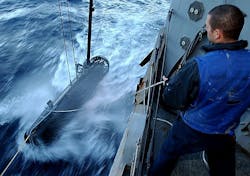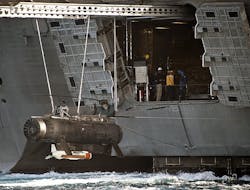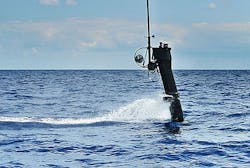One component of the LCS counter-mine package is in trouble, but others are ready to step-up
THE MIL & AERO BLOG, 15 Dec. 2015. The U.S. Navy and Lockheed Martin Corp. are under fire over allegations that an unmanned mine-hunting system built by Lockheed Martin plays an unreliable role in the counter-mine package of the Navy's Littoral Combat Ship (LCS).
At issue is the AN/WLD-1 Remote Minehunting System (RMS) from the Lockheed Martin Mission Systems and Training segment in Riviera Beach, Fla. The RMS is a 23-foot-long semiautonomous, semisubmersible diesel-powered unmanned submarine designed to locate and classify undersea anti-ship mines.
The RMS reportedly often fails to work, after 16 years of development and a Navy investment of nearly $700 million. Pentagon weapons testers say the versions of the RMS have failed 24 times since September 2014.
Most recently, the drones failed 14 times over 300 hours in a five-month round of preliminary trials at sea that ended Aug. 30, say investigators at the U.S. Department of Defense Office of Operational Test & Evaluation. Crippled RMS vehicles reportedly were towed to port seven times during testing last summer.
Allegations were detailed earlier this month in a story by Anthony Capaccio that appeared in Bloomberg entitled The Navy's $864 Million Underwater Drones Still Don't Work.
U.S. Sen. John McCain, R-Ariz., has been criticizing the Navy Lockheed Martin RMS since late last summer when tests suggested the system is not as effective as Navy leaders would like in countering ocean anti-ship mines. McCain chairs the Senate Armed Services Committee.
Lockheed Martin officials, meanwhile, say the RMS meets Navy performance parameters, and is the only system on track for delivery that can fill imminent capability gap.
Granted, the RMS has taken a lot of time and money to develop, and I believe it's likely that the Navy and Lockheed Martin will iron out its problems to make it a reliable, effective system.
If the worst happens and the RMS turns out to be a big waste of time and money, it doesn't mean that U.S. and allied naval forces are especially vulnerable to sea-based mines. Other systems are deployed or are in development that can fill the counter-mine role.
In the unlikely event that the RMS is declared a failed program and cancelled, there are other systems and technologies that can help fill the gap. Unmanned underwater vehicle (UUV) technologies are progressing rapidly to fill the counter-mine role.
Related: New ship takes lead in countermine and anti-submarine warfare
The Navy, for example, has asked Hydroid Inc. in Pocasset, Mass., to ramp-up production of the company's MK 18 Kingfish family of unmanned submersibles for counter-mine warfare, as well as for underwater reconnaissance and surveillance.
The MK 18 UUV is a variant of the Hydroid REMUS 600, which Hydroid developed originally developed through funding from the Office of Naval Research (ONR) in Arlington, Va., to support the Navy's UUVs with extended endurance, increased payload capacity, and greater operating depth.
The REMUS 600 can dive to depths of nearly 2,000 feet, and can operate on one battery charge for as long as 24 hours. The UUV is for mine countermeasures; harbor security; debris field mapping; search and salvage; scientific sampling and mapping; hydrographic surveys; environmental monitoring; and fishery operations. REMUS is short for Remote Environmental Measuring Unit S.
The Littoral Combat Ship itself does not rely solely on the RMS for finding and neutralizing ocean mines. The ship's counter-mine package also will have the AN/AES-1 Airborne Laser Mine Detection System (ALMDS) from Northrop Grumman Corp. The AN/AQS-22 Airborne Low Frequency Sonar system from Raytheon also will deploy helicopters aboard the LCS.
The LCS also can deploy AN/ALQ-220 Organic Airborne and Surface Influence Sweep (OASIS) system from an MH-60S helicopter. The ship also can deploy the Battlespace Prep Autonomous Underwater Vehicle (BPAUV) countermine reconnaissance system from Bluefin Robotics Corp. that uses a side-scan sonar system to detect and map anti-ship mines.
The counter-mine arsenal of the LCS doesn't stop there. The ship also can deploy the Raytheon AN/AQS-20 Minehunting Sonar System, a towed body for single-pass detection and classification of volume and bottom mines.
Yet another system on the LCS’s MH-60S helicopter is the AN/AWS-2 Rapid Airborne Mine Clearance System (RAMICS) from Northrop Grumman. It takes coordinates from the Northrop Grumman AN/AES-1 Airborne Laser Mine Detection System and fires special 20 mm projectiles to destroy mines quickly in water as deep as 300 feet.
The LCS also will be able to deploy an unmanned surface vehicle (USV) called Spartan, an autonomous rigid-hull inflatable-boat (RHIB) sensor platform for long-duration surveillance, anti-submarine, and countermine warfare.
Even with all of this, other counter-mine systems are in development for deployment form the LCS. The RMS simply isn't the only game in town.




